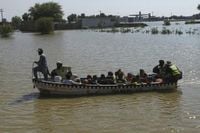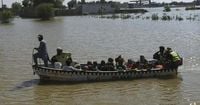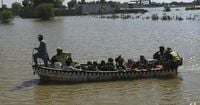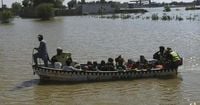In the early hours of Tuesday, September 9, 2025, tragedy struck on the swollen Indus River in Pakistan’s eastern Punjab province. A rescue boat, tasked with evacuating flood victims from danger, capsized under the force of strong winds and fast currents, killing nine people—including women and children—according to government officials and multiple reports from The Associated Press.
The ill-fated boat was carrying 20 desperate passengers, many of whom had already lost their homes to the relentless monsoon floods that have ravaged the region since late June. Musarrat Jabeen, the region’s top government administrator, explained that the vessel lost balance as it battled the river’s ferocious surge. After an hours-long rescue operation, five bodies were initially recovered. By early Thursday, September 11, four more were pulled from the water by teams that included Pakistan Army divers, according to AP coverage.
This heartbreaking incident is not isolated. Just days before, on Saturday, September 6, a similar disaster unfolded near Jalalpur Pirwala city, also in Punjab. There, five people perished when another rescue boat capsized as the Chenab and Sutej rivers burst their banks, flooding the region following water releases from Indian dams. These repeated tragedies have cast a harsh spotlight on the region’s ongoing battle with natural disasters and the human cost of climate-driven extremes.
The scale of the crisis is staggering. Relief Commissioner Nabil Javed told AP that nearly 142,000 people in Jalalpur Pirwala and dozens of nearby villages have been affected, with tens of thousands displaced from their homes. Since August 23, floods have submerged about 4,000 villages across Punjab, displacing 2.1 million people and killing at least 68, according to the Punjab Disaster Management Authority. Nationally, the death toll from floods since late June has soared past 900.
For those who survived, the aftermath has been grim. Many have found temporary shelter with relatives, while others huddle in relief camps or camp out along embankments, hoping for a reprieve. The floods have not only swept away homes and livelihoods but also left survivors in a precarious state, waiting for help that sometimes seems slow to arrive.
Frustrations among flood-hit communities have grown. Residents of Jalalpur Pirwala complained that there were not enough evacuation boats and that private operators were charging excessive fares. In response, Senior Punjab Cabinet Minister Marriyum Aurangzeb assured locals on Thursday that she was personally overseeing rescue and relief efforts. She promised, according to AP, to address their concerns and ensure that aid reached those in need.
Punjab Chief Minister Maryam Nawaz Sharif also visited the city, meeting with affected families and issuing a stern warning to private boat owners. "After my visit to Jalalpur, I have directed strict police monitoring of all boat operations," she declared on social media, as reported by AP. Sharif ordered police to take action against anyone demanding high fees from stranded families and pledged that the government would compensate private boat owners for their participation in rescue efforts.
To bolster the rescue operation, emergency services have deployed 100 boats equipped with life jackets and floodlights, along with four helicopters to facilitate evacuations and food delivery. These resources are vital as the region continues to grapple with the threat of rising waters and the logistical challenges of reaching remote or isolated communities.
But the roots of the disaster run deeper than immediate weather conditions. Officials have pointed to heavier-than-normal monsoon rains and repeated water releases from overflowing Indian dams as key factors exacerbating the flooding. The cross-border dynamics of water management add another layer of complexity—and tension—to an already dire situation.
With so many displaced and entire villages submerged, the human toll is not just measured in numbers. The stories emerging from Punjab are ones of resilience and loss, hope and frustration. Some families, having lost everything, now cling to the promise of government aid and the efforts of first responders. Others, still waiting for help, voice their anger at what they see as inadequate preparation and slow response.
The government’s response has been multi-faceted, aiming to address both immediate needs and longer-term recovery. In addition to deploying rescue boats and helicopters, officials have set up relief camps and are working to reinforce embankments to prevent further flooding, particularly around Jalalpur Pirwala where deluges continue to threaten nearby villages.
Yet, as the days wear on, the challenges only seem to multiply. Displaced residents face uncertain futures, with their homes and farmland underwater and their communities scattered. Aid organizations and government agencies are stretched thin, racing against time and the elements to provide food, shelter, and medical care.
Amid all this, the question lingers: Could more have been done to prevent such loss of life? The complaints about insufficient boats and profiteering by private operators suggest gaps in the disaster response infrastructure. The government’s promises of compensation and police oversight are welcome, but for many, they come too late to save loved ones lost in the swirling floodwaters.
As the region looks ahead, the lessons from this year’s catastrophic monsoon season are painfully clear. Climate change is intensifying weather patterns, making extreme events like these more frequent and severe. Effective disaster preparedness, cross-border cooperation on water management, and robust emergency response systems are no longer optional—they are essential for safeguarding vulnerable communities.
The people of Punjab, battered but unbowed, continue to wait for the waters to recede and for life to return to some semblance of normalcy. Their resilience is evident, but so too is their need for sustained support and decisive action from those in power. For now, the focus remains on saving lives, providing relief, and learning from the tragedies that have unfolded along the banks of the Indus and beyond.
As the floodwaters slowly begin to ebb, the true cost of this disaster will only become clearer, etched in the memories of those who survived—and in the resolve of a region determined to rebuild.




